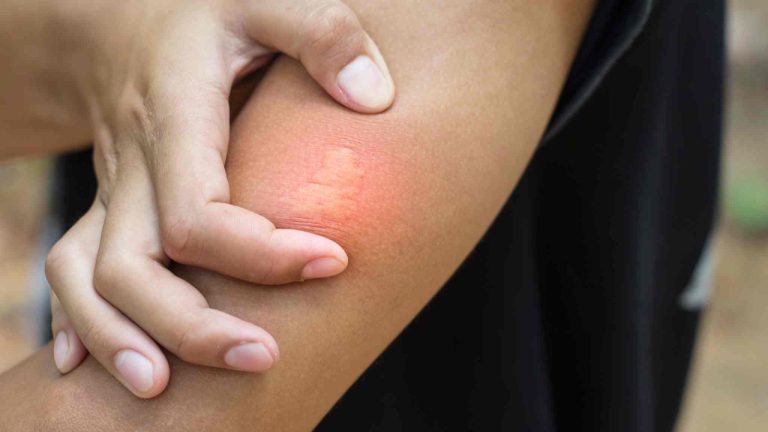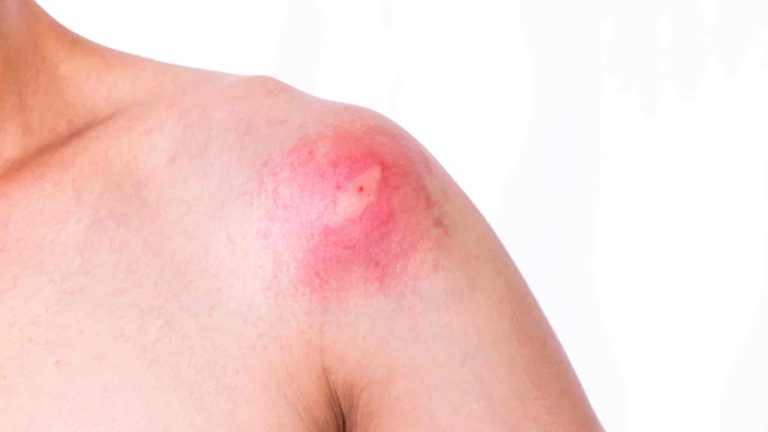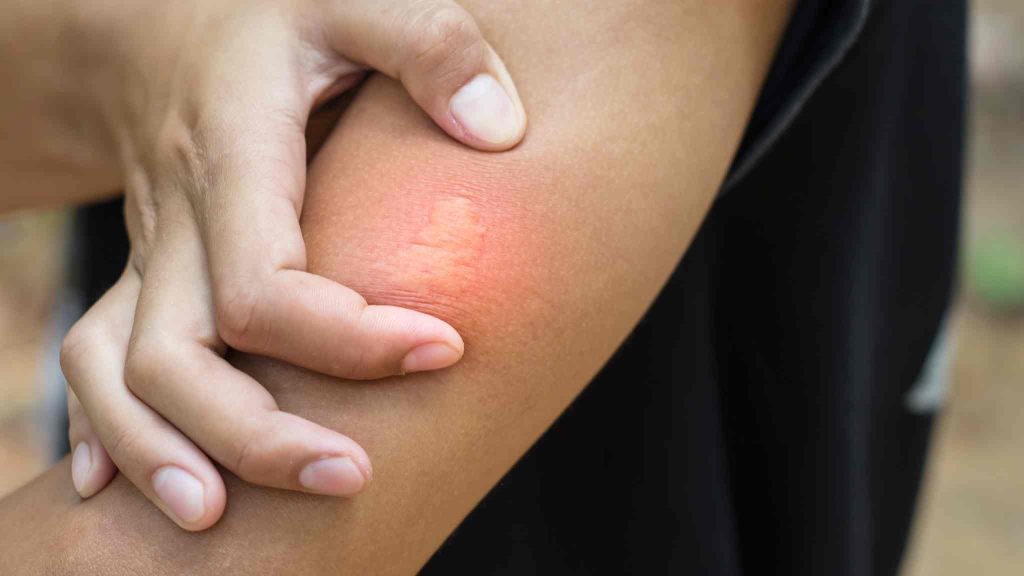First Aid For A Bee Sting And Other Insect Bites

In our first aid training, we cover all of the most common scenarios both in work and out.
Although a tick bite or a bee sting can be excruciatingly painful, most often they don’t cause any severe problems. You can have anaphylaxis to bites and stings, but they are quite rare.
It can cause widespread pain around the area of the skin, and it can become quite red and painful.
But normally, that’s the extent of it. It usually doesn’t end up being much more of a reaction than that. Stings around the face can cause serious envenomation and difficulty breathing even though a person may not have been allergic before.
First Aid For A Bee Sting
What happens when we get stung?
When bees sting, they leave a little sack of venom, which they’ll continue to inject from that sack of venom. So you have to be really careful, as it continues to eject into the skin, whereas wasps and ants and similar, can sting you more than once, injecting toxins.
We have to be careful with ticks. And although you may not feel a tick latching on, you may not see it or know it’s there until you can see or feel it. They can inject a toxin that can cause irritants of the skin. They can also cause an allergic reaction like anaphylaxis, as can any of these.
These can be life-threatening; it doesn’t just have to be food, and there doesn’t need to have been any previous exposure to these kinds of things.
We have to remember that in anaphylaxis with food, there are specific symptoms, which are tightness in your throat, the change in the voice, persistent cough and dizziness which is a blood pressure dropping.
But one of the mild to moderate symptoms of food allergy is abdominal pain and vomiting, whereas, with a sting or a bite from an insect, abdominal pain and vomiting are signs of anaphylaxis.
Bites are less likely to cause anaphylaxis than stings.
First aid for a wasp sting and other biting insects
This is where your first aid training comes in handy – recognition of symptoms.
With a bee sting, what you should do is remove it by any means possible, try and find a leaf or a card or a credit card or anything like that.
With a tick, we need to be careful. So if you do find that you’ve got a tick on you, don’t panic and try to remove it immediately; the best way that you can remove a tick is by freezing it off. Things like wart spray. Take yourself to the nearest chemist or your GP. This way you’re going to kill it without actually injecting anything further into you.a

If your child is not having a reaction, then just using a cold compress would be absolutely fine. There’s really not a lot else that you can do for this kind of in if you’re not having a reaction but just remember to remove those stings, as quickly as possible so that they don’t continue to inject venom into you and with a tick, you have to have to freeze them first.
Emergency Situations
Symptoms may be accompanied by some of the more mild/moderate symptoms of hives or swelling of the face or other parts of the body affected by the sting. As we said before, some people may just have some pain and tenderness.
However 3% of adults will have anaphylaxis due to an insect bite or sting.
Anaphylaxis from a bite or sting can present in many different ways. Lets recap the symptoms of anaphylaxis:
- Difficult or noisy breathing
- Swelling of the tongue
- Swelling or tightness in the throat
- Wheeze or persistent cough
- Difficulty talking or hoarse voice
- Persistent dizziness or collapse
- Pale and floppy (young children)
- Abdominal pain, vomiting
First line treatment for anaphylaxis is adrenaline. Nothing else will stop the effects of anaphylaxis taking hold.

If you have an adrenaline autoinjector:
- Casualty should be either laid down or at the very least sat down. If the casualty is unconscious or pregnant, place them in the recovery position.
- Source the adrenaline autoinjector
- If the casualty is a small child, sit the child sideways on your lap, and hold them in the position shown below.
- Administer the adrenaline autoinjector into the outside mid-thigh
- This can be administered through clothes but avoid any trouser seams
- Phone emergency services
- If you have a second adrenaline autoinjector, and after 5 minutes the symptoms of anaphylaxis are the same or worse, administer a second dose
- Monitor breathing
- If the casualty stops breathing at any point, start CPR
If you do not have an adrenaline autoinjector:
- Lay or at the very least sit the casualty down. If the casualty is a very young child, lay them flat in your arms.
- Call emergency services
- Monitor breathing
- If the casualty stops breathing at any point, start CPR
First Aid Courses
The First Aid Nest specialise in group workplace first aid Australia wide.
Choose from various different delivery options from 80% online to 100% full face to face. It’s entirely up to you and how your workforce would best learn.
Contact us today or simply book via our website and we will be in touch within 24 hours to lock in a date for you. We can’t wait to meet you!


